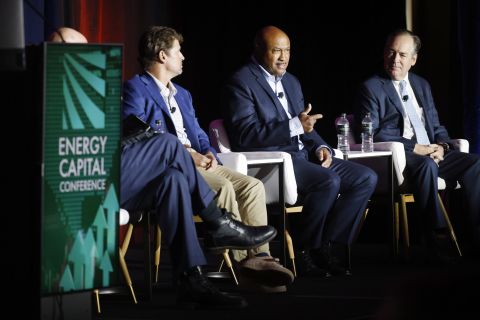BP Plc on May 6 announced new production units in the Gulf of Mexico, enhancing its standing as the largest producer there at a time when rival global oil majors are scrambling to expand vast U.S. onshore shale drilling.
U.K.-based BP will add two new subsea production units about two miles (3.2 km) south of its existing giant Thunder Horse platform, with two wells added in the near term and eight total wells planned, the company said on Monday. BP did not disclose the cost of the investment.
RELATED ARTICLE: BP Cranks Up Thunder Horse Expansion Project In GoM
The investment runs against current industry trends that emphasize spending on shale, which has propelled U.S. production to more than 12 million barrels a day (MMbbl/d), making it the largest producer in the world. U.S. offshore production accounts for 1.8 MMbbl/d, but has grown more slowly.
Like its rivals, BP has completed a massive onshore acquisition, buying BHP Billiton's onshore assets for $10.5 billion to improve its shale position.
That new investment has not detracted from the company's plans for the Gulf.
People familiar with BP’s investment decisions told Reuters that the Gulf’s vast oil reservoirs and increasingly affordable platforms make the formation a good hedge against the risks of shale, where industry's per-well productivity has dropped by 1% from its 2016 high. Among deepwater basins, the Gulf of Mexico's reliable regulatory climate makes the region particularly attractive, analysts say.
BP said it plans to increase its Gulf production to about 400,000 barrels of oil equivalent per day (boe/d) by the mid 2020s. That’s about a fifth of the region’s total production. The company’s Gulf production has already increased more than 60 percent from 2013 to more than 300,000 boe/d.
"Those big fields keep on giving,” Starlee Sykes, the company’s president for operations in the region, told Reuters.
New Seismic Imaging Technology
The new development at Thunder Horse will add 50,000 gross doe/d of production, with first oil expected in 2021. That’s more crude from a single project than the total Permian production BP acquired as part of the deal with BHP Billiton.
BP used new seismic imaging capabilities to identify an additional 1 billion barrels of oil in place at the Thunder Horse field.
“One of the significant advantages of deepwater or offshore wells relative to onshore U.S. wells is their high productivity,” said Emeka Emembolu, BP’s Gulf of Mexico vice president for reservoir development. “On average, Deepwater Gulf of Mexico wells produce around 5,000 barrels of oil per day.”
Some offshore wells have production rates starting at 30,000 barrels per day, he said. That’s compared with an average of just 650 barrels a day for Permian wells, according to U.S. Energy Department statistics.
Offshore developments traditionally require hefty upfront investment, but improved recovery technologies have reduced project costs. BP has reduced its per-barrel costs to $40 a barrel or less – on par with wells in the best shale formations.
"Growth in onshore oil can only provide 1% to 20% of what the market needs year-on-year in terms of volume growth, so that's why you see continued activity in the Gulf of Mexico, in offshore Brazil, and new basins popping up," said Andrew Slaughter, executive director, Deloitte Center for Energy Solutions.
Still, in the United States shale has overshadowed the Gulf. Chevron Corp and Occidental Petroleum Corp are locked in a battle for Anadarko Petroleum Corp., with both touting onshore and liquefied natural gas assets as key attractions of the deal, rather than Anadarko’s Gulf platforms. Anadarko produces roughly 140,000 bbl/d from the Gulf.
Separately, Exxon Mobil Corp. has started a sale process to identify a buyer for 45,000 bbl/d of Gulf production interests and Royal Dutch Shell agreed to sell a production platform last month.
BP has maintained a position in each of the five largest Gulf fields, and it also is one of the few of late bidding on areas not adjacent to existing properties in the Gulf.
The rest, mostly the majors and a few niche regionally-focused independent companies, have centered their exploration around acreage next to existing platforms.
Recommended Reading
Post Oak Backs New Permian Team, But PE Faces Uphill Fundraising Battle
2024-10-11 - As private equity begins the process of recycling inventory, likely to be divested from large-scale mergers, executives acknowledged that raising funds has become increasingly difficult.
Post Oak-backed Quantent Closes Haynesville Deal in North Louisiana
2024-09-09 - Quantent Energy Partners’ initial Haynesville Shale acquisition comes as Post Oak Energy Capital closes an equity commitment for the E&P.
EQT to Cut Workforce 15% Following Close of Equitrans Acquisition
2024-10-02 - EQT Corp. closed its $5.5 billion all-stock buy of Equitrans Midstream Corp. on Sept. 22.
Diamondback to Sell $2.2B in Shares Held by Endeavor Stockholders
2024-09-20 - Diamondback Energy, which closed its $26 billion merger with Endeavor Energy Resources on Sept. 13, said the gross proceeds from the share’s sale will be approximately $2.2 billion.
Marathon Oil Expects ‘Mass Layoff’ After ConocoPhillips Deal Closes
2024-10-31 - Marathon Oil’s merger with ConocoPhillips, which is to close by year-end, will trigger a layoff of more than 500 Houston employees, according to a state regulatory filing.





